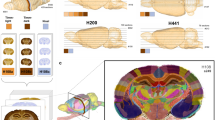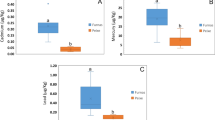Summary
The zinc concentration in the brains of two species of lizard was determined by atomic-absorption spectrophotometry. The zinc concentration was found to be highest in the telencephalon of Lacerta galloti (21.1 μg/g fresh weight) and Podarcis hispanica (16.77±0.8 μg/g) while the mesencephalon and brain stem exhibited lower zinc concentrations, i.e., 7.0 μg/g in Lacerta galloti and 6.08±0.4 μg/g in Podarcis hispanica. This high telencephalic concentration of zinc is paralleled by intense and well-defined Timm reactivity used for demonstrating the presence of zinc-containing boutons at the light-microscope level. Volumetricdensitometric studies of these Timm-reactive zones were performed using serial transverse sections of the same lizard brains.
Similar content being viewed by others
References
Assaf SI, Chung SH (1984) Release of endogenous Zn2+ from brain tissue during activity. Nature 308:734–736
Crawford IL (1983) Zinc and the Hippocampus. In: Dreosti IE, Smith RM (eds) Neurobiology of the trace elements. Humana Press, Clifton, pp 163–211
Danscher G (1984a) Do the Timm sulphide silver method and the selenium method demonstrate zinc in the brain? In: Frederickson CJ, Howell GA, Kasarskis EJ (eds) The neurobiology of zinc. Part A: Physyochemistry, anatomy and techniques. Alan R Liss, New York, pp 273–287
Danscher G (1984b) Dynamic changes in the stainability of rat hippocampal mossy fiber boutons after local injection of sodium sulphide, sodium selenite, and sodium diethyldithiocarbamate. In: Frederickson CJ, Howell GA, Kasarskis EJ (eds) The neurobiology of zinc. Part B: Deficiency, toxicity and pathology. Alan R Liss, New York, pp 177–191
Danscher G, Haug FMS (1971) Depletion of metal in the rat hippocampal mossy fibre system by intravital chelation with dithizone. Histochemie 28:211–219
Danscher G, Haug FMS, Fredens K (1972) Effect of diethyldithiocarbamate (DEDTC) on dulphide silver stained boutons. Exp Brain Res 16:521–532
Danscher G, Hall E, Fredens K, Fjerdingstad E, Fjerdingstad EJ (1975) Heavy metals in the amigdala of the rat: zinc, lead and copper. Brain Res 94:167–172
Danscher G, Howell G, Perez-Clausell J, Hertel N (1985) The dithizone, Timm's sulphide silver and the selenium methods demonstrate a chelatable pool of zinc in CNS. Histochemistry 83:419–422
Fleischhauer K, Horstmann E (1957) Intravitaler Dithizonfarburg homologer Felder der Ammonsformation von Sauger. Z Zellforsch 46:598–609
Frederickson CJ, Klitenick MA, Manton WI, Kirkpatrick JB (1983) Cytoarchitectonic distribution of zinc in the hippocampus of man and the rat. Brain Res 273:335–339
Haug FMS (1967) Electron microscopical localization of the zinc in hippocampal mossy fiber synapses by a modified sulfide silver procedure. Histochemie 8:355–368
Howell GA, Welch MG, Frederickson CJ (1984) Stimulation induced uptake and release of zinc in hippocampal slices. Nature 308:736–738
Hu KH, Friede RL (1968) Topographic determination of zinc in human brain by atomic absorption spectrophotometry. J Neurochem 15:677–685
Ibata Y, Otsuka N (1969) Electron microscopic demonstration of zinc in the hippocampal formation using Timm's sulfide-silver technique. J Histochem Cytochem 17:171–175
Kalinowski M, Wolf G, Markefski M (1983) Concentration and subcellular localization of zinc in the hippocampal formation, cerebellum, and whole brain during the postnatal development of the rat. Acta Histochem 73:33–40
Kemp K, Danscher G (1979) Multi-element analysis of the rat hippocampus by proton induced x-ray emission spectroscopy (phosphorus, sulphur, chlorine, potassium, calcium, iron, zinc, copper, lead, bromine and rubidium). Histochemistry 59:167–176
Ketelslegers JM (1969) Localisation histochimique du zinc dans le telencephale du lezard Lacerta muralis. Cellule 58:69–75
Kozma M, Ferke A, Kasa P (1978) Ultrastructural identification of neural elements containing trace metals. Acta Histochem 62:142–154
Kozma M, Ferke A (1979) Trace element localization and changes in zinc and copper concentrations during postnatal development of the rat CNS. Acta Histochem 65:219–227
Lopez-Garcia C, Molowny A, Perez-Clausell J (1983a) Volumetric and densitometric study in the cerebral cortex and septum of a lizard (Lacerta galloti) using the Timm method. Neurosci Lett 40:13–18
Lopez-Garcia C, Soriano E, Molowny A, Garcia-Verdugo JM, Berbel P, Regidor J (1983b) The Timm positive system of axonic terminals of the cerebral cortex of Lacerta. In: Grisolia S, Guerri C, Samson F, Norton S, Reinoso-Suarez F (eds) Ramon y Cajal's contribution to the neurosciences. Elsevier, Amsterdam, pp 137–148
Lopez-Garcia C, Molowny A, Perez-Clausell J, Martinez-Guijarro FJ (1984) A sulphide-osmium procedure for detection of metalcontaining synaptic boutons in the lizard cerebral cortex. J Neurosci Methods 11:211–220
Martinez Guijarro FJ, Berbel P, Molowny A, Lopez-Garcia C (1984) Apical dendritic spines and axonic terminals in the bipyramidal neurons of the dorsomedial cortex of lizards (Lacerta). Anat Embryol 170:321–326
Maske H (1955) Über den topochemischen Nachweis von Zink im Ammonshorn verschiedener Säugetiere. Naturwissenschaften 42:424–425
McLardy T (1960) Neurosyncytial aspects of the hippocampal mossy fiber system. Confin Neurol 20:1–17
Molowny A, Lopez-Garcia C (1978) Estudio citoarquitectonico de la corteza cerebral de reptiles. III: Localization histoquimica de metales pesados y definicion de subregiones Timm positivas en la corteza de Lacerta, Chalcides, Tarentola y. Malpolon. Trab Inst Cajal Invest Biol 70:55–74
Molowny A (1980) Estudio de la corteza cerebral de Locerta y otros reptiles con la tecnica de Timm. Doctoral Thesis, Universidad de La Laguna (Tenerife), Spain
Perez-Clausell J, Danscher G (1985) Intravesicular localization of zinc in rat telencephalic boutons. A histochemical study. Brain Res 336:91–99
Szerdahelyi P, Kasa P (1985) Demonstration of reduced levels of zinc in rat brain after treatment with d-amphetamine, but not after treatment with reserpine. Histochemistry 83:181–187
Timm F (1958) Zur Histochemie des Ammonshorngebietes. Z Zellforsch 48:548–555
Von Euler C (1961) On the significance of the high zinc content in the hippocampal formation. In: Physiologie de l'hippocampe. CNRS, Paris, 107:135–145
Author information
Authors and Affiliations
Rights and permissions
About this article
Cite this article
Molowny, A., Martinez-Calatayud, J., Juan, M.J. et al. Zinc accumulation in the telencephalon of lizards. Histochemistry 86, 311–314 (1987). https://doi.org/10.1007/BF00490264
Received:
Accepted:
Issue Date:
DOI: https://doi.org/10.1007/BF00490264




